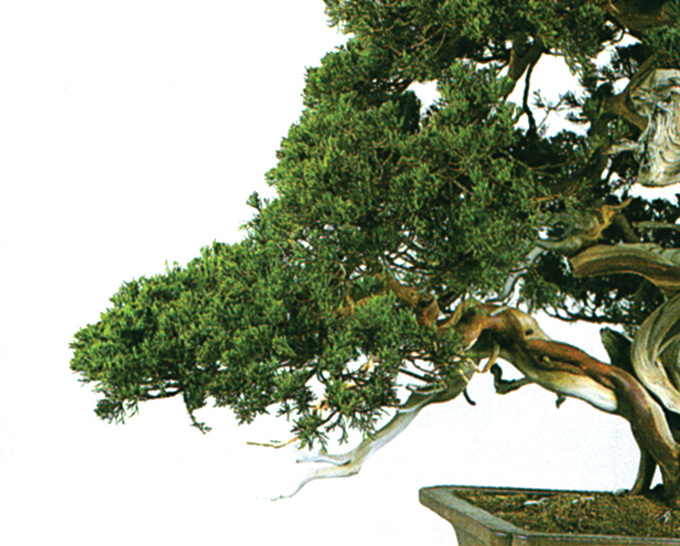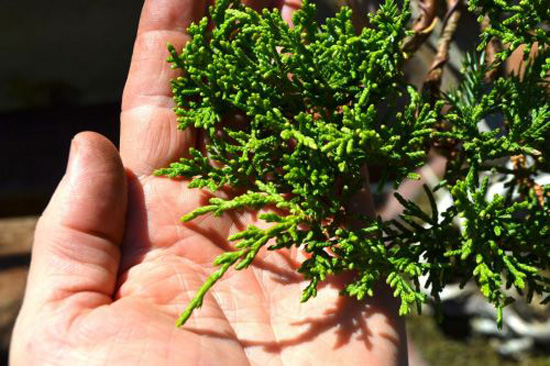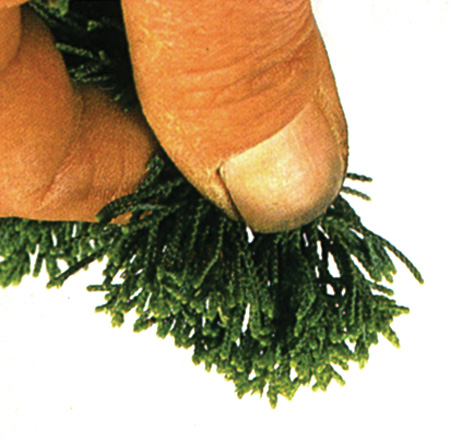 Was this tree pinched? Shimpaku juniper by Kunio Kobayashi from Bonsai Today issue 28.
Was this tree pinched? Shimpaku juniper by Kunio Kobayashi from Bonsai Today issue 28.
Never pinch junipers!
I’ve been ripping off valuable tidbits from Michael Hagedorn’s Crataegus Bonsai for a long time (always attributed and linked of course). Micheal is a noted American bonsai artist, teacher and author and a voice for a common sense approach to bonsai.
Michael’s latest post is titled ‘Never Pinch Junipers.’ In his own words… Basically, we don’t pinch junipers. We cut new long extensions with scissors…and I know that will raise some eyebrows. I think the idea of pinching junipers with fingers started long ago in translated Japanese articles written by those who did not specialize in or have much experience in junipers. And then we bought into the idea of pinching because it seemed like a way to have fun with our junipers. But pinching, especially over-pinching where every growing tip is removed, has been killing junipers for decades. There’s more here.
 Don’t pinch! Michael Hagedorn’s (?) hand showing off some deliciously healthy looking juniper foliage that he’ll never pinch.
Don’t pinch! Michael Hagedorn’s (?) hand showing off some deliciously healthy looking juniper foliage that he’ll never pinch.
Pinch junipers!
When Michael mentions “the idea of pinching junipers with fingers started long ago in translated Japanese articles written by those who did not specialize in or have much experience in junipers” I thought uh oh, could it be Bonsai Today that hes’ referring to? The early issue of Bonsai Today were translated from Japanese to Spanish to English. The person doing the Spanish to English knew absolutely nothing about bonsai and, at that time, almost no one else in the West did either (quite possibly including the person translating from Japanese to Spanish). So it’s easy to see how misconceptions could be passed on and be interpreted as bonsai gospel.
Which brings us to an article in Bonsai Today issue 28 (1993) where Kunio Kobayashi (he’s famous and it’s well earned) where he is quoted as saying “The objective of pinching is to remove the leaves in areas of strong growth, so that you keep the strong branches from growing too long and, at the same time, bring into balance the vigor of the tree’s strong branches (which are pinched) with that of the weak ones (that are not pinched).” There’s more, but you get the drift.
 Pinch! If you look at this photo (from the Kunio Kobayashi article in Bonsai Today 28), it looks like he’s showing us how to pinch juniper foliage. When you combine the photo with the text (even considering all the possibilities for mistranslation) it’s seem that he clearly advocated pinching (at least in 1993).
Pinch! If you look at this photo (from the Kunio Kobayashi article in Bonsai Today 28), it looks like he’s showing us how to pinch juniper foliage. When you combine the photo with the text (even considering all the possibilities for mistranslation) it’s seem that he clearly advocated pinching (at least in 1993).
A way out of our dilemma
I’m loath to disagree with Michael on any bonsai topic, but equally reluctant to disagree with Mr. Kobayashi. Fortunately, I think there’s a way out (beyond the old saw about reasonable people disagreeing); it’s when Michael says “But pinching, especially over-pinching where every growing tip is removed, has been killing junipers for decades. So, maybe you can still pinch your junipers, as long as you don’t over-pinch. Or…?
First of all I appreciate Bonsaibark and enjoy reading your material. Further, anyone who shops around online and does any apples to apples comparisons will or should order everything from Stone Lantern. Not intended as anything negative towards anyone else but from my experience with numerous places you guys are the best. Anyway I quit “pinching” all my shimpaku’s a year or more ago after noticing the ones I was only thinning and what not would not only recover from whatever malady but quickly overtake the ones being “pinched” and considered otherwise healthy. Until I read this information this morning I thought it was maybe because I live in Florida and the trees needed treated a bit differently because of our climate here; but, maybe not. Fascinating reading and thanks again!!
Thanks for you kind words Lance and pretty good advice is I say so myself (and no, I didn’t put him up to it).
I have been pinching Juniper procumbens for a while. Some thoughts; never pinch the majority of ends on any branch; never pinch after transplanting (plants need auxins for root tip generation; Never pinch in the hot or very wet season, as this will lead to tip scorch, or invite fungal infection (eg;phomopsis) respectively. From May-Sept, cautiously (or incrementally) pinch ends that shade other areas (said areas are not yet fully light-adapted). Consider antidessicants and avoid full sun after pinching. Pinching shaded ends is almost always tolerated well throughout the growing season.
Roy Nagatoshi advocates cutting exclusively, giving a “haircut”, to maintain outline and encourage tighter foliage pads. Can’t argue with his results. GL
Thanks Michael,
Good advise. Especially the part about never pinching (cutting) the majority of tips after transplanting.
And yeah, I guess you wouldn’t want to argue with Roys’ results.
Hi Guys. I asked Roy Nagatoshi to do a demo for us at Kofu Kai in Anaheim in July specifically on the subject of trimming or grooming kiishu shimpaku. His technique is more specific than just a haircut and I’ve been using it successfully for years. Trouble is, it’s kind of hard to put into words and most people seem to need to see it in person to really understand what he’s acvocating. When I visited him before the demo to set things up, I proposed that we try to write an article on the subject but Roy convinced me that it would be unlikely that we could make the technique clear in words and photos, or even diagrams. People seeing this for the first time have a lot of very specific questions for one thing and also, the areas he’s working on are very limited and precise. By the way, although people often wander out of demos and go home early, no one left early at this event. Roy had everyone gather near him so that they could see exactly what he was doing and I’m pretty sure that most of them ‘got it’, so no more poodley shimpakus showing up at shows, right? In my dreams, I know.
Well, I believe that you are talking about two different things. The pinching that mr Kobayashi is showing is, I beleive more of a thinning process than control of length. I guarantee you, if you repeatedly “pinch” junipers over the growing cycle like illustrated you will end up with a ball of foliage that is only at the “tips”. Mike, Ryan, Marco and Boon (among many others) who have trained in Japan with top notch folks do not “pinch” trees regularly for growth control. SOme pinch during the year a tree will be shown, but too many times very high end trees have been ruined because folks pinch them as their primary method for increasing density and maintaining an outline. Let them grow, prune them back to wood and then let them grow again. This argument reminds me of the good ole days she folks used to control JBP growth by starving and depriving them of water, because that is what they learned. Don’t see much of that now, do you?
Very good article. I think the best take away is that aggressive, frequent pinching of junipers is bad. I have a semi-cascade garden juniper that I aggressively pruned a couple of years ago and it is still alive, but not vigorous. I watered well, fertilized at full strength and provided full sun and adequate air circulation and it’s on its way back. Now, I only cut very long end shoots to maintain shape and style and thin out some interior shoots to prevent death of foliage from excessive shading from shoots from above.
I stopped pinching Junipers (shimpaku, Itoigawa, procumbens) years ago. I notice the same thing Michael Hagedorn (and others) did, basically that it lead the very weak, and eventually dead trees. Since I primarily work on shohin-sized trees, I go in with bud shears every 6 to 8 weeks and perform a combination of thinning and tip removal. This keeps the tip foliage tight and at a consistent length, yet with sufficient air/sun spaces and the trees very healthy. It also fosters growth from inside the tree to eventually create replacement branches. I would never recommend anyone pinch juniper tips, for any reason. Take a little extra time and care with bud-thinning shears!
Surely it should be possible in this day and age to to a video presentation of this technique for people who do not have the advantage of someone like Roy Nagatoshi on their door step
In the Uk I was told by John Hanby years ago never to pinch scale juniper foliage but to use scissors on the extending shoots – the key seems to be letting the tree grow so it strengthens, then trim back to shape. constant pinching to form the pad profile never lets the branch gain strength, so branches weaken so much they die.
Rigida and communis needle juniper is totally different though – first let the shoots extend and cut with scissors, then pinch new shoots for the rest of the growing season – they are totally different in growth and habit to scale junipers so need treating differently
Hi,
You said that this tree was wired from a young age. Was the wire left on the tree and allow to scar it to help creat the shari or was it removed and then the shari created? I have read alot of things related to the twisting of shimpaku but nothing about the creation of the sharis??
Hi Bob,
I’m not sure what tree you are referring to. It must be in another post.
Anyway, though it is possible that a wire scar could be a starting point for a shari, they are typically not created by wire scarring. Artificial shari are usually created by carving with hand and/or power tools. Another technique involves peeling back a dead branch stump with pliers. And of course, you would have to remove wire before peeling or carving.
If you google shari you can find more detail info on how to do it. Back issues of Bonsai Today also have plenty of good info.
Hi Len,
I looked for the video you are referring to and couldn’t find it.
How about a link?
Thanks,
-w